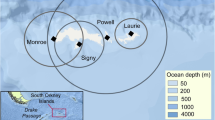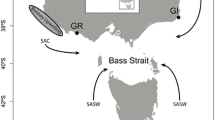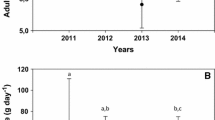Abstract
To help meet the high energy demands of raising the young, some seabirds alternate between short, frequent foraging trips to maximize food delivery to the young, and infrequent, long foraging trips that serve towards self-maintenance. Our study is the first to investigate the foraging behaviour of gentoo penguins at Marion Island, which we did through a combined use of GPS loggers and time-depth recorders. The shallow shelf between Marion and Prince Edward Islands proved to be an important foraging area, and penguins exploited this area using a novel foraging strategy. Penguins undertook alternating trips of relatively short and long durations. Short trips, performed in the afternoon, were likely associated with self-maintenance as they were followed by roosting on the beach overnight and not returning to the colony. They were followed by longer and more distant foraging trips, after which birds returned to the colony to provision chicks. To our knowledge, this is the first study to demonstrate alternating trip lengths in gentoo penguins and the first to associate short trips with self-maintenance in seabirds. We suggest that due to the close proximity of a predictable foraging area for these penguins at Marion Island, there is minimal energetic cost to return to land after self-provisioning. Hence, unlike other seabirds that feed at greater distances from their breeding colonies, gentoo penguins are afforded the opportunity for short self-maintenance trips. Finally, we argue that these birds may be using this novel strategy due to sub-optimal feeding conditions resulting from environmental change.






Similar content being viewed by others
References
Adams NJ, Klages NT (1989) Temporal variation in the diet of the gentoo penguin Pygoscelis papua at sub-Antarctic Marion Island. Colon Waterbirds 12:30–36. doi:10.2307/1521309
Adams NJ, Wilson MP (1987) Foraging parameters of gentoo penguins Pygoscelis papua at Marion Island. Polar Biol 7:51–56. doi:10.1007/BF00286824
Allan EL, Froneman PW, Durgadoo JV, McQuaid CD, Ansorge IJ, Richoux NB (2013) Critical indirect effects of climate change on sub-Antarctic ecosystem functioning. Ecol Evol 3:2994–3004. doi:10.1002/ece3.678
Angelier F, Bost C-A, Giraudeau M, Bouteloup G, Dano S, Chastel O (2008) Corticosterone and foraging behavior in a diving seabird: the Adélie penguin, Pygoscelis adeliae. Gen Comp Endocrinol 156:134–144. doi:10.1016/j.ygcen.2007.12.001
Ansorge IJ, Lutjeharms JRE (2002) The hydrography and dynamics of the ocean environment of the Prince Edward Islands (Southern Ocean). J Mar Syst 37:107–127. doi:10.1016/S0924-7963(02)00198-7
Ansorge IJ, Durgadoo JV, Pakhomov EA (2009) Dynamics of physical and biological systems of the Prince Edward Islands in a changing climate. Pap Proc R Soc Tasmania 143:15–18
Bannasch R, Wilson RP, Culik B (1994) Hydrodynamic aspects of design and attachment of a back-mounted device in penguins. J Exp Biol 194:83–96
Birdlife International (2016) Pygoscelis papua. IUCN Red List of Threatened Species 2016. http://www.iucnredlist.org/details/22697755/0. Accessed 09 Dec 2016
Bost C-A, Jouventin P (1990) Evolutionary ecology of gentoo penguins (Pygoscelis papua). In: Davis LS, Darby JT (eds) Penguin biology. Academic Press Inc, San Diego, pp 85–112
Brown ZW, Welcker J, Harding AMA, Walkusz W, Karnovsky NJ (2012) Divergent diving behavior during short and long trips of a bimodal forager, the little auk Alle alle. J Avian Biol 43:215–226. doi:10.1111/j.1600-048X.2012.05484.x
Calenge C (2006) The package adehabitat for the R software: a tool for the analysis of space and habitat use by animals. Ecol Model 197:516–519
Carpenter-Kling T (2016) Foraging ecology of the gentoo penguin, Pygoscelis papua, at Marion Island. Dissertation. Nelson Mandela Metropolitan University
Clarke JR (2001) Partioning of foraging effort in Adélie penguins provisioning chicks at Béchervaise Island, Antarctica. Polar Biol 24:16–20
Clarke JR, Emmerson LM, Otahal P (2006) Environmental conditions and life history constraints determine foraging range in breeding Adélie penguins. Mar Ecol Prog Ser 310:247–261. doi:10.3354/meps310247
Crawford RJM, Cooper J, Dyer BM, Wolfaardt AC, Tshingana D, Spencer K, Petersen SL, Nel JL, Keith DG, Holness CL, Hansie B, Greyling MD, Du Toit M (2003) Population, breeding, diet and conservation of the Crozet shag Phalacrocorax [atriceps] melanogenis at Marion Island, 1994/95-2002/2003. Afr J Mar Sci 25:537–547
Crawford RJM, Dyer BM, Upfold L, Makhado AB (2014) Congruent, decreasing trends of gentoo penguins and Crozet shags at sub-Antarctic Marion Island suggest food limitation through common environmental forcing. Afr J Mar Sci 36:225–231. doi:10.2989/1814232X.2014.926293
Croxall JP, Davies RW, O’Connell MJ (1988) Diving patterns in relation to diet of gentoo and macaroni penguins at South Georgia. Condor 90:157–167
Delord K, Barbraud C, Weimerskirch H (2004) Long-term trends in the population size of king penguins at Crozet archipelago: environmental variability and density dependence? Polar Biol 27:793–800. doi:10.1007/s00300-004-0651-z
Dewitt HH, Heemstra PC, Gon O (1990) Nototheniidae. In: Gon O, Heemstra PC (eds) Fishes of the Southern Ocean. J. L. B. Smith Institute of Ichthyology, Grahamstown, pp 279–331
Downes SM, Budnick AS, Sarmiento JL, Farneti R (2011) Impacts of wind stress on the Antarctic Circumpolar Current fronts and associated subduction. Geophys Res Lett 38:1–6. doi:10.1029/2011GL047668
Emlen JM (1966) The role of time and energy in food preference. Am Nat 100:611–617
Espitalier-Noël G, Adams NJ, Klages NT (1988) Diet of the imperial cormorant Phalacrocorax atriceps at sub-Antarctic Marion Island. Emu 88:43–46
Fretwell SD, Calver JS (1969) On territorial behavior and other factors influencing habitat distribution in birds. Acta Biotheor 19:37–44. doi:10.1007/BF01601954
Gales RP (1985) Validation of the stomach-flushing technique for obtaining stomach contents of penguins. Ibis (Lond 1859) 129:335–343
Handley JM, Baylis AMM, Brickle P, Pistorius P (2016) Temporal variation in the diet of gentoo penguins at the Falkland Islands. Polar Biol 39:283–296. doi:10.1007/s00300-015-1781-1
Hothorn T, Hornil K, Van De Wiel MA, Zeileis A (2006) A Lego system for conditional inference. Am Stat 60:257–263
Hunt BP V, Pakhomov EA (2003) Mesozooplankton interactions with the shelf around the sub-Antarctic Prince Edward Islands archipelago. J Plankton Res 25:885–904. doi:10.1093/plankt/25.8.885
Jakubas D, Iliszko L, Wojczulanis-Jakubas K, Stempniewicz L (2012) Foraging by little auks in the distant marginal sea ice zone during the chick-rearing period. Polar Biol 35:73–81. doi:10.1007/s00300-011-1034-x
Jansen JK, Boveng P, Bengtson J (1998) Foraging modes of chinstrap penguins: contrasts between day and night. Mar Ecol Prog Ser 165:161–172. doi:10.3354/meps165161
Johnson DS, London JM, Lea M, Durban JW (2008) Continuous-time correlated random walk model for animal telemetry data. Ecology 89:1208–1215
Kokubun N, Takahashi A, Mori Y, Watanabe S, Shin H-C (2010) Comparison of diving behavior and foraging habitat use between chinstrap and gentoo penguins breeding in the South Shetland Islands, Antarctica. Mar Biol 157:811–825. doi:10.1007/s00227-009-1364-1
Kranstauber B, Smolla M (2016) move: Visualizing and analyzing animal track data. http://CRAN.R-project.org/package=move
Lescroël A, Bost C-A (2005) Foraging under contrasting oceanographic conditions: the gentoo penguin at Kerguelen Archipelago. Mar Ecol Prog Ser 302:245–261. doi:10.3354/meps302245
Lescroël A, Ridoux V, Bost C-A (2004) Spatial and temporal variation in the diet of the gentoo penguin (Pygoscelis papua) at Kerguelen Islands. Polar Biol 27:206–216. doi:10.1007/s00300-003-0571-3
Luque SP (2007) diveMove: dive analysis in R. R News 7:8–14
Luque SP, Fried R (2011) Recursive filtering for zero offset correction of diving depth time series with GNU R package diveMove. PLoS One 6:e15850. doi:10.1371/journal.pone.0015850
Lynch HJ (2013) The gentoo penguin (Pygoscelis papua). In: García Borboroglu P, Boersma PD (eds) Penguins: natural history and conservation. University of Washington Press, Washington, pp 79–88
Lyver PO, MacLeod CJ, Ballard G, Karl BJ, Barton KJ, Adams J, Ainley DG, Wilson PR (2011) Intra-seasonal variation in foraging behavior among Adélie penguins (Pygocelis adeliae) breeding at Cape Hallett, Ross Sea, Antarctica. Polar Biol 34:49–67. doi:10.1007/s00300-010-0858-0
MacArthur RH, Pianka ER (1966) On optimal use of a patchy environment. Am Nat 100:603–609
Magalhães MC, Santos RS, Hamer KC (2008) Dual-foraging of Cory’s shearwaters in the Azores: feeding locations, behaviour at sea and implications for food provisioning of chicks. Mar Ecol Prog Ser 359:283–293. doi:10.3354/meps07340
Masello JF, Mundry R, Poisbleau M, Demongin L, Voigt CC, Wikelski M, Quillfeldt P (2010) Diving seabirds share foraging space and time within and among species. Ecosphere 1:art19. doi:10.1890/ES10-00103.1
Mattern T, Ellenberg U, Houston DM, Davis LS (2007) Consistent foraging routes and benthic foraging behaviour in yellow-eyed penguins. Mar Ecol Prog Ser 343:295–306. doi:10.3354/meps06954
McConnell BJ, Chambers C, Fedak MA (1992) Foraging ecology of southern elephant seals in relation to the bathymetry and productivity of the Southern Ocean. Antarct Sci 4:393–398
Miller AK, Karnovsky NJ, Trivelpiece WZ (2009) Flexible foraging strategies of gentoo penguins Pygoscelis papua over 5 years in the South Shetland Islands, Antarctica. Mar Biol 156:2527–2537. doi:10.1007/s00227-009-1277-z
Miller AK, Kappes MA, Trivelpiece SG, Trivelpiece WZ (2010) Foraging-niche separation of breeding gentoo and chinstrap penguins, South Shetland Islands, Antarctica. Condor 112:683–695. doi:10.1525/cond.2010.090221
Orians GH, Pearson NE (1979) On the theory of central place foraging. In: Horn DJ, Mitchell RD, Stairs GR (eds) Analysis of ecological systems. Ohio State University Press, Colombus, pp 154–177
Paiva VH, Geraldes P, Ramírez I, Meirinho A, Garthe S, Ramos JA (2010) Oceanographic characteristics of areas used by Cory’s shearwaters during short and long foraging trips in the North Atlantic. Mar Biol 157:1385–1399. doi:10.1007/s00227-010-1417-5
Pakhomov EA, Bushula T, Kaehler S et al (2006) Structure and distribution of the slope fish community in the vicinity of the sub-Antarctic Prince Edward Archipelago. J Fish Biol 68:1834–1866. doi:10.1111/j.1095-8649.2006.01076.x
Pelletier L, Chiaradia A, Kato A, Ropert-Coudert Y (2014) Fine-scale spatial age segregation in the limited foraging area of an inshore seabird species, the little penguin. Oecologia 176:399–408. doi:10.1007/s00442-014-3018-3
Perissinotto R, McQuaid CD (1992) Land-based predator impact on vertically migrating zooplankton and micronekton advected to a Southern Ocean archipelago. Mar Ecol Prog Ser 80:15–27
Pinaud D, Weimerskirch H (2002) Ultimate and proximate factors affecting the breeding performance of a marine top-predator. Oikos 99:141–150
R Core Team (2016) R: a language and environment for statistical computing
Rishworth GM, Tremblay Y, Green DB, Pistorius PA (2014) An automated approach towards measuring time-activity budgets in colonial seabirds. Methods Ecol Evol 5:854–863. doi:10.1111/2041-210X.12213
Robinson SA, Hindell MA (1996) Foraging ecology of gentoo penguins Pygoscelis papua at Macquarie Island during the period of chick care. Ibis (Lond 1859) 138:722–731
Ropert-Coudert Y, Wilson RP, Daunt F, Kato A (2004) Patterns of energy acquisition by a central place forager: benefits of alternating short and long foraging trips. Behav Ecol 15:824–830. doi:10.1093/beheco/arh086
Saraux C, Robinson-Laverick SM, Le Maho Y, Ropert-Coudert Y, Chiaradia A (2011) Plasticity in foraging strategies of inshore birds: how little penguins maintain body reserves while feeding offspring. Ecology 92:1909–1916. doi:10.1890/11-0407.1
Shoji A, Aris-Brosou S, Fayet A et al (2015) Dual foraging and pair coordination during chick provisioning by Manx shearwaters: empirical evidence supported by a simple model. J Exp Biol 218:2116–2123. doi:10.1242/jeb.120626
Spitz J, Trites AW, Becquet V, Brind’Amour A, Cherel Y, Galois R, Ridoux V (2012) Cost of living dictates what whales, dolphins and porpoises eat: the importance of prey quality on predator foraging strategies. PLoS One 7:1–7. doi:10.1371/journal.pone.0050096
Stearns SC (1976) Life-history tactics: a review of the ideas. Q Rev Biol 51:3–47
Stephens DW, Krebs JR (1986) Foraging theory. Princeton University Press, New Jersey
Sumner MD (2015) trip: tools for the analysis of animal track data. https://CRAN.R-project.org/package=trip
Takahashi A, Kokubun N, Mori Y, Shin H-C (2008) Krill-feeding behaviour of gentoo penguins as shown by animal-borne camera loggers. Polar Biol 31:1291–1294. doi:10.1007/s00300-008-0502-4
Taylor SS, Leonard ML, Boness DJ, Majluf P (2002) Foraging by Humboldt penguins (Speniscus humboldti) during the chick-rearing period: general patterns, sex differences, and recommendations to reduce incidental catches in fishing nets. Can J Zool 80:700–707. doi:10.1139/z02-046
Tremblay Y, Cherel Y (2000) Benthic and pelagic dives: a new foraging behaviour in rockhopper penguins. Mar Ecol Prog Ser 204:257–267. doi:10.3354/meps204257
Trivers RL (1974) Parent-offspring conflict. Am Zool 14:249–264
Tveraa T, Lorentsen S, Ssether B (1997) Regulation of foraging trips and costs of incubation shifts in the Antarctic petrel (Thalassoica antarctica). Behav Ecol 8:465–469. doi:10.1093/beheco/8.5.465
Weimerskirch H (1998) How can a pelagic seabird provision its chick when relying on a distant food resource? Cyclic attendance at the colony, foraging decision and body condition in sooty shearwaters. J Anim Ecol 67:99–109
Weimerskirch H, Chastel O, Ackermann L et al (1994) Alternate long and short foraging trips in pelagic seabird parents. Anim Behav 47:472–476
Welcker J, Harding AMA, Karnovsky NJ, Steen H, Strøm H, Gabrielsen GW (2009) Flexibility in the bimodal foraging strategy of a high Arctic alcid, the little auk Alle alle. J Avian Biol 40:388–399. doi:10.1111/j.1600-048X.2008.04620.x
Williams TD, Rothery P (1990) Factors affecting variation in foraging and activity patterns of gentoo penguins (Pygoscelis papua) during the breeding season at Bird Island, South Georgia. J Appl Ecol 27:1042–1054
Williams TD, Briggs DR, Croxall JP, Naito Y, Kato A (1992) Diving pattern and performance in relation to foraging ecology in the gentoo penguin, Pygoscelis papua. J Zool Lo 227:211–230. doi:10.1111/j.1469-7998.1992.tb04818.x
Wilson RP, Grant WS, Duffy DC (1986) Recording devices on free-ranging marine animals: does measurement affect foraging performance? Ecology 67:1091–1093
Wilson RP, Puetz K, Bost C-A, Culik BM, Bannasch R, Reins T, Adelung D (1993) Diel dive depth in penguins in relation to diel vertical migration of prey: whose dinner by candlelight? Mar Ecol Prog Ser 94:101–104. doi:10.3354/meps094101
Wilson RP, Culik BM, Peters G, Bannasch R (1996) Diving behavior of gentoo penguins, Pygoscelis papua; factors keeping dive profiles in shape. Mar Biol 126:153–162
Worton BJ (1989) Kernel methods for estimating the utlization distribution in home-range studies. Ecology 70:164–168
Ydenberg RC, Welham CVJ, Schmid-Hempel R, Beauchamp G (1994) Time and energy constraints and the relationships between cuurencies in foraging theory. Behav Ecol 5:28–34
Zimmer I, Wilson RP, Beaulieu M, Ropert-Coubert Y, Kato A, Ancel A, Plötz J (2010) Dive efficiency versus depth in foraging emperor penguins. Aquat Biol 8:269–277. doi:10.3354/ab00213
Zuur AF, Ieno EN, Walker NJ, Saveliev AA, Smith GM (2009) Mixed effects models and extensions in ecology with R. Spinger, New York
Acknowledgements
We thank all the field personnel who assisted with the deployment and retrieval of instruments, with special mention of Vonica Perold, Geneveive Moroke, Alexis Osborne and Zuko Nkomo. Research on Marion Island is made possible through the logistical support from the Department of Environmental Affairs and financial support from the South African National Antarctic Programme. We are most grateful for funding received from the National Research Foundation (South Africa). RRR was supported by a National Research Foundation SANCOR post-doctoral fellowship (Grant Number 94916).
Author information
Authors and Affiliations
Corresponding author
Ethics declarations
Funding
Funding for this project was provided by the South African National Antarctic Programme, National Research Foundation (1. Grant number: SNA14073082526 awarded to Dr Pierre Pistorius; 2. Grant number SNA2005060800001 awarded to Dr Rob Crawford).
Ethical approval
All procedures performed were in accordance with the ethical standards of Nelson Mandela Metropolitan University (Permit number A14-SCI-ZOO-012) and supported by the Department of Environmental Affairs’ Branch Oceans and Coasts, the management authority of South Africa’s marine and coastal environment.
Conflict of interest
The authors declare that they have no conflict of interest.
Additional information
Responsible Editor: V. Paiva.
Reviewed by undisclosed experts.
Electronic supplementary material
Below is the link to the electronic supplementary material.
Rights and permissions
About this article
Cite this article
Carpenter-Kling, T., Handley, J.M., Green, D.B. et al. A novel foraging strategy in gentoo penguins breeding at sub-Antarctic Marion Island. Mar Biol 164, 33 (2017). https://doi.org/10.1007/s00227-016-3066-9
Received:
Accepted:
Published:
DOI: https://doi.org/10.1007/s00227-016-3066-9




